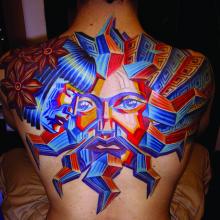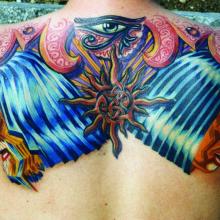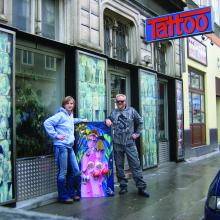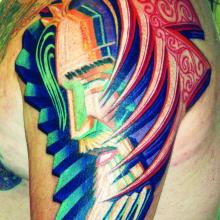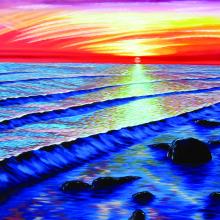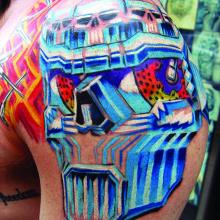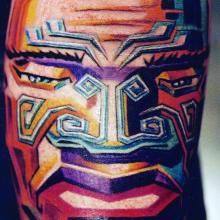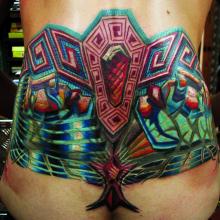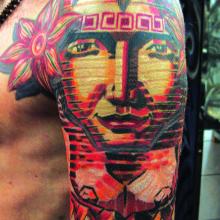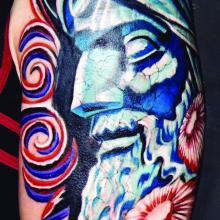
I met the Austrian artist and painter Waldi for the first time in 1998 during a tattoo convention in Castrop Rauxel, Germany. I was very impressed by his colourful, biomechanical style but without its lugubrious feelings of the Jugendstil (Art Nouveau Movement) from Vienna. Since 1998, vibrant colours have visually inspired Waldi, especially by those of his journeys to the magical island of Cuba.
Waldi (real name Waldemar Wahn) originally comes from Poland but has spent a long time in Vienna. His studio ‘Shocking City’ is located in the artist quarter of the Austrian capital, which he runs with his daughter Osa who is also a tattoo artist and painter. The walls of his studio are adorned with many of their oil paintings making a trip there a fantastic visual experience. Waldi tattoos opened in Vienna in 1992. ‘Back then there were only five artists working in Austria including Claus Fuhrmann’ he tells me. ‘They were underground studios located in cellars. I had my first studio in Bad Ischl, which is 300 kilometres from Vienna. But after having problems with the police, I decided to move to the capital.’
EXPRESSIONIST
In the past Waldi has painted many industrial designs and was heavily inspired by the Jugendstil and the Renaissance movement of Vienna. ‘I get inspired by everything I see: when I am walking along the street, past shop-windows I love the way the sun is shining through the windows of these buildings.’ he says. ‘Everything I see I store in my head. I compose my paintings and tattoos from all the impressions I have. And when I travel, I use my experiences in my designs.’
Waldi considers himself as an expressionist artist. ‘For a tattoo I give the maximum of expression. I don’t see a tattoo as just a decoration. I talk with the customer, as I want to know more about them in a way that I can impart a personal meaning to the tattoo. I will give them my opinion about the tattoo. If he doesn’t share my opinion, then it’s better for him to search another tattooist.’
A HUGE PALETTE OF COLOURS
Waldi is also a prolific painter. His tattoos are like paintings and his customers are often people who know about his art. ‘Every artist has to be involved in different art forms because they compliment each other’ he says. ‘I can’t imagine only painting. On a painting you have total freedom but with a tattoo it’s different. A tattoo inspires more. From a good tattoo I’d rather make an oil-painting then the other way round.’ Waldi always tries to improve his material, for example the colours. ‘When I tattoo I use a wide palette of colours. I have about thirty-three different graduations of colour. With five different kinds of purples, blues and reds. With oil paintings I use so many different colours. I consider the research into colour as a science. A tattoo artist always has to take the effect of a certain colour into consideration; I mean this can alter the final effect on the skin. Because on a painting it’s different. If an artist doesn’t know the effects of different colours working together, this can affect the skin, and he could spoil the tattoo.’
According to Waldi a tattoo artist has to take the form of the body as a starting-point and not think of the canvas as flat paper. ‘The form of the body defines the composition. For example with the upper arm is defined by the biceps, the triceps and the way the elbows are bent. Many artists work in the other way, they start from the paper and make then the tattoo. I am against that.’
LA PRINCESSA DE WOODOO DE HAVANA
Waldi’s recent work has been inspired by a journey he made to Cuba, by the colours and the light of the island, and not only by that, but by the whole atmosphere of everything that he saw around him there. His designs are called ‘Puesta del sol de Malecón’ (sunset on the Malecón, the famous boulevard of Havana), ‘La princessa de woodoo de Havana’ and ‘La bodeguito del medio’; this is the bar that the famous American writer Ernest Hemingway drunk the mojito, (a typical Cuban cocktail of rum, soda, sugar and mint). Waldi went to Cuba for a holiday and he was instantly fascinated and captivated by the country. He decided to study Cuban and Latin American art there for a year in Havana, the Cuban capital. Waldi: ‘First I took Spanish lessons for four months. Actually I learned most of it from the robbers on the streets, from the people who tried to sell me cigars, to those who try to get money out of the tourists. That was very irritating, but I could soon turn them down with the Spanish I had learned. I lived in the slums and experienced terrible times there but as a human being it made me richer. Of course I have my memories of communism in Poland and experienced the powerlessness during those days. That can have a big influence on your personality. My stay in Cuba helped me to overcome the powerlessness of my past.’
FRACTURE OF STYLES
Waldi doesn’t tattoo in Cuba. But the culture of the country has influenced his artistic development to a high extent. ‘In many ways you have a collaboration of styles in Cuba. That occurs when you mix two or more styles andthat happens often in this country. Cuba has known colonialism and slavery and there is the influence from Spain, France and Africa. These cultures have mixed in such a way that from this mix a whole new culture arose. In this respect Cuba is most inspiring for an artist like myself.’ Waldi gave me the following example of what he considers as a fracture of styles. ‘In Havana you see the decay of the houses and buildings, especially in Havana Vieja. The occupants of these houses drive around in those old American cars from the fifties: the Cadillac’s and the Chevy’s. At the same time you see how the Afro-Cubans profess the Cuban form of voodoo: santeria, which origin is African, brought by the Yoruba tribe to Cuba and mixed up in the slavery days with Catholicism because back then, slaves may not profess their own religions. Besides that you see the Chinese who came to Cuba in the 19th century to work there and the Spanish who stayed in Cuba since the Conquistadores or immigrated later. These many fractures of styles are unique to Cuba.’ Considering the work of Waldi, he tells me he painted the streets of Havana in different perspectives. ‘All the painters who come to Cuba, painted the streets, so I did that too. For example I painted La Bodeguita del Medio or I painted an old American car in a street in Havana. But this car doesn’t fit into the impressionistic style in which I paint. For example the houses are in decay, but the cars are coming from a totally different atmosphere and time zone, from the rockabilly era. This for me, is a fracture of styles.
THE COLOURS OF CUBA
Waldi returned in the December of 2004 once more to the island to take photographs. He wants to use them later in his designs. But for him not only are the images important but also the rich colours. The light and colours of Cuba are very different to those in Europe and theUSA. Because I have now been to Cuba sereral times, I can imagine how the colours of the country have influenced the way in which Waldi is tattooing and painting. Waldi: ‘You can see the Cuban influence in my tattoos. But that’s not the main reason for my stay in Cuba. My tattoos and paintings aren’t only a play of colours. Every image has a deeper power of expression and meaning. Every image is a comment on certain issues like religion and politics. And my stay in Cuba helped me to look at the world in a different way and to develop an impressionistic way of painting and tattooing. It made my style change.’ And because he learned to speak Spanish, the Spanish speaking and Latin-American world is now open for him. ‘I have come a step closer to that Latin culture. You can see that in my paintings and tattoo-designs I’m certain.’
Shocking City
Burggasse 63-1070 Vienna.
Austria. Tel: 004315228067

